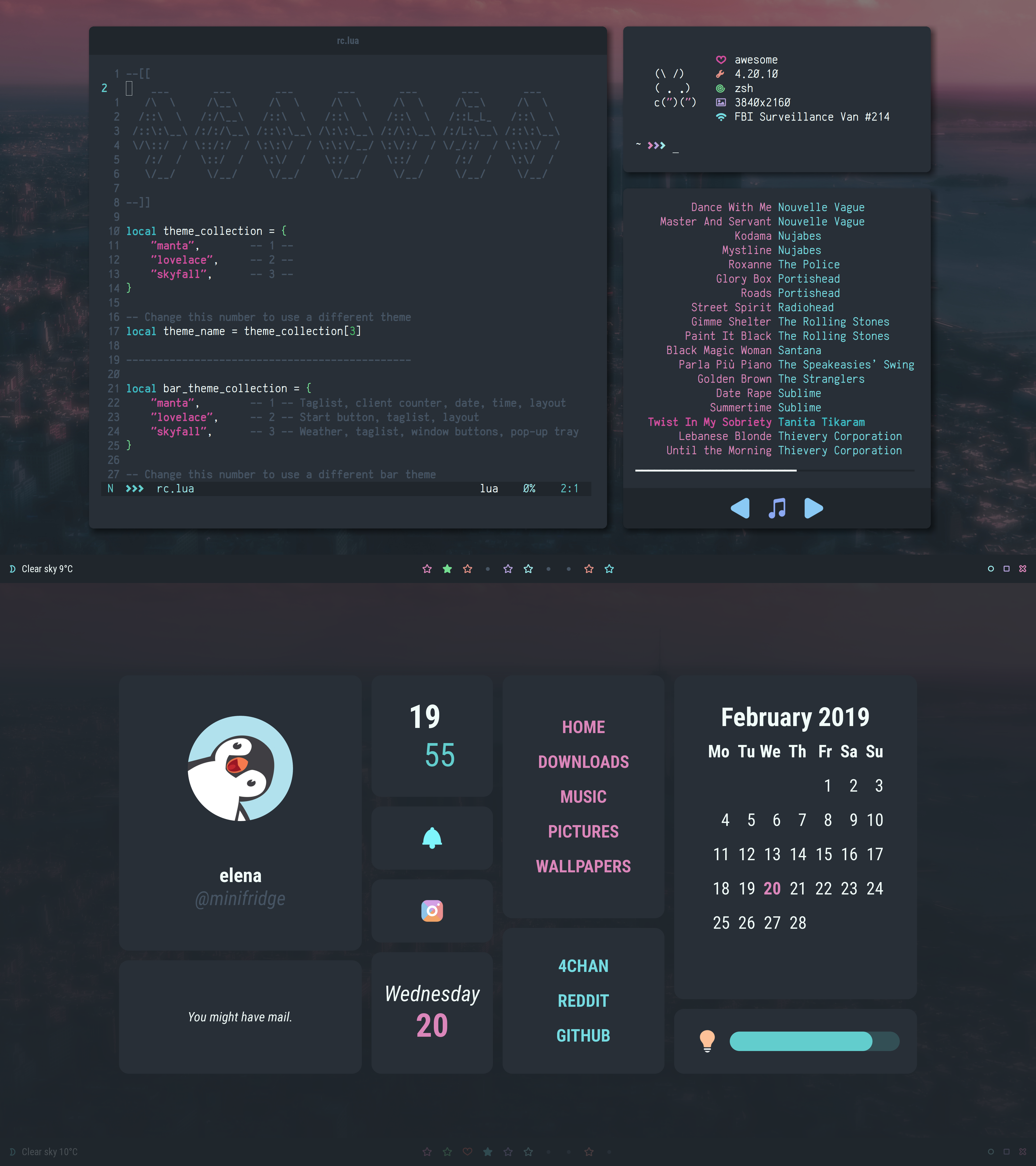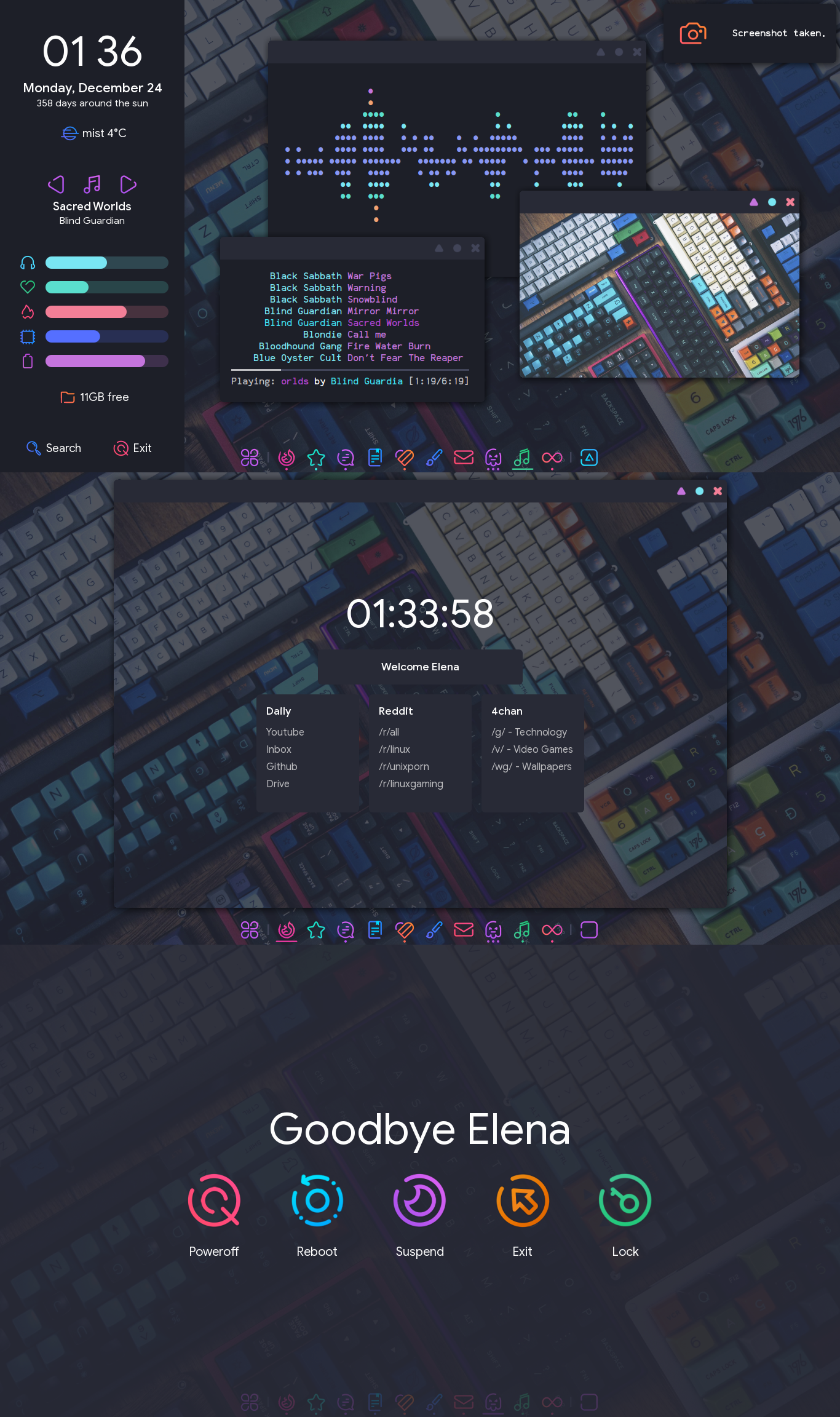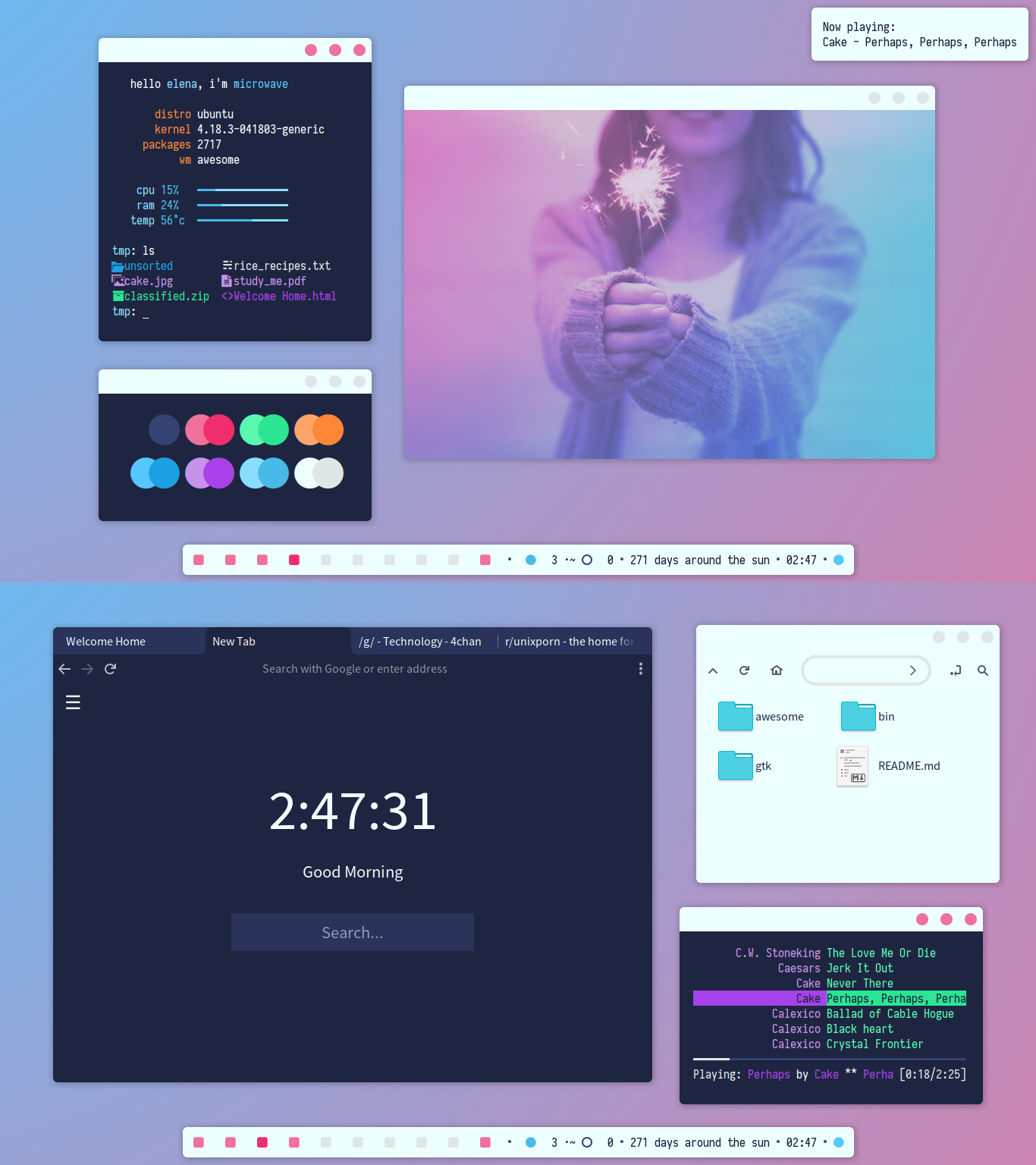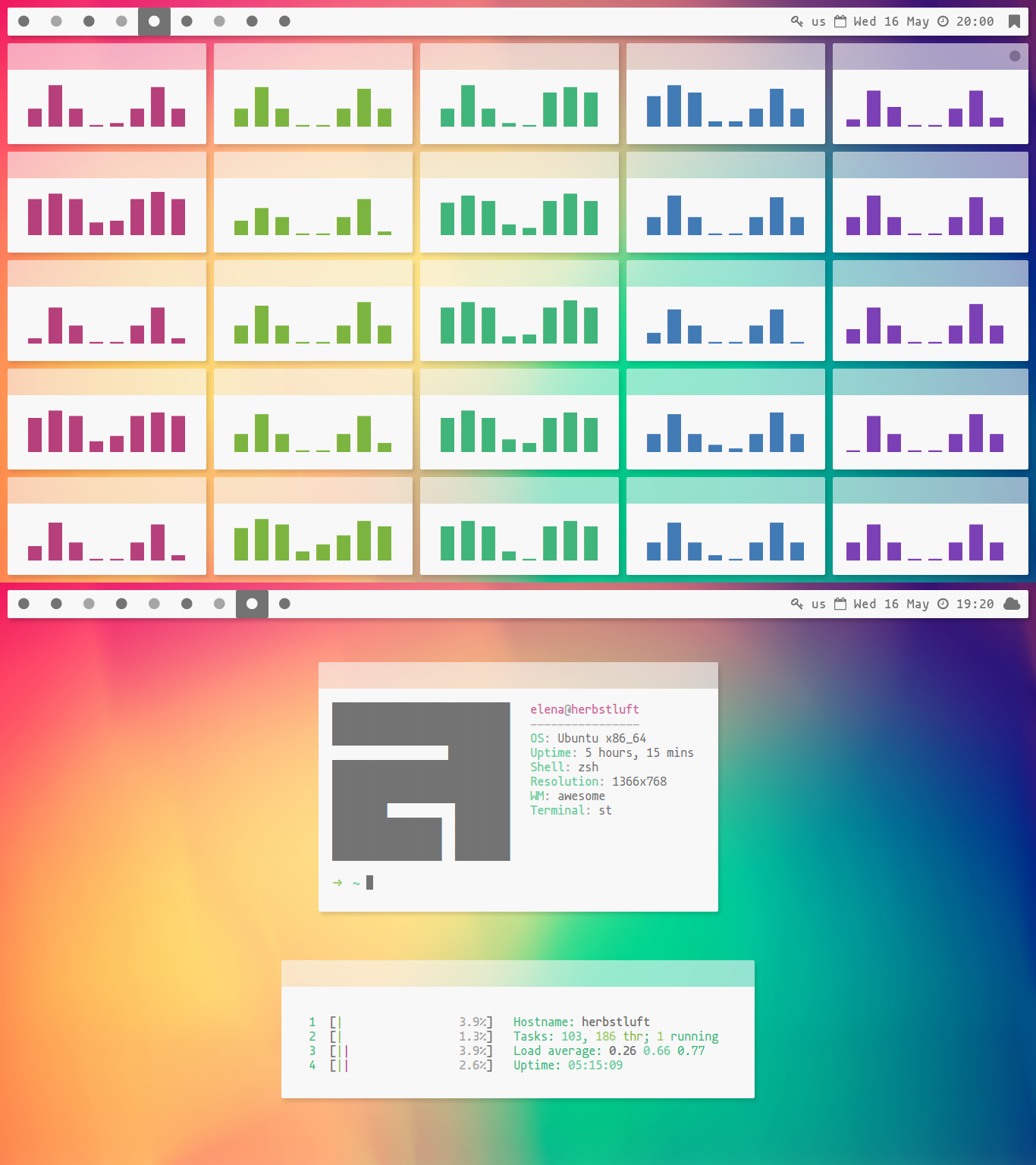dotfiles
Some details
- OS: Antergos
- WM: Awesome
- Terminal: xst (fork of Suckless terminal)
- File Manager: Nemo for GUI, Ranger for terminal
- Bar Icons: Typicons Font
- Launcher: Rofi
- Editor: Vim
- Browser: Firefox
Latest preview
Tips / Notes
-
You can open an issue if you have any questions / problems.
-
If you are new to AwesomeWM...
I suggest you start from the default configuration and add pieces you like to it instead of trying to modify someone else's configuration even if you feel really comfortable with that specific config. Otherwise you will have no idea how anything works and how you can modify things to your own liking. Trust me, I've been there.
-
Don't forget to use the API Documentation for AwesomeWM.
It is well written and has plenty of examples.
File structure
-
I have split my
rc.luainto multiple files for organization purposes. -
The
noodledirectory contains widgets that usually take up more than 50 lines of code.I prefer not filling my
bars.luawith a ton of widget configurations, but also not making a seperate file for every widget. -
In
themesyou can find a directory for each available theme.Such a directory should include at least a
theme.luaand optionally icons, wallpaper, and whatever asset you need that is theme-specific. -
In
bar_themesyou can find a.luafile for each available bar or bar group.Multiple bars can be created in one file.
Some recommended applications
- Terminals: Termite / Kitty / urxvt / st
- File managers: Nemo / Thunar
- Launchers: Rofi / dmenu
- Browsers: Firefox (with Vimium extension) / Qutebrowser
- Editors: Vim / Sublime Text (with NeoVintageous plugin) / Spacemacs
- Music players: mpd (with ncmpcpp)
Things to do before trying out these dotfiles
-
Configure default applications
In
rc.luathere is a section where default applications such as terminal, editor and file manager are defined. You should change those to your liking. -
Configure autostart applications in
autostart.sh -
Install rofi
I use rofi extensively for window switching and launching stuff.
-
Install a Nerd Font
Nerd Fonts are monospace fonts with a ton of icons included. I use them quite a lot in my bars as icons.
-
Have a general idea of what my keybinds do
My keybinds will most probably not suit you, but on your first login you might need to know how to navigate the desktop.
See the next section for more details.
Basic keybinds
I use super AKA Windows key as my main modifier.
Keyboard
super + enter- Spawn terminalsuper + shift + enter- Spawn floating terminalsuper + d- Launch rofisuper + shift + q- Close clientsuper + control + space- Toggle floating clientsuper + [1-0]- View tag AKA change workspace (for you i3 folks)super + shift + [1-0]- Move focused client to tagsuper + s- Tiling layoutsuper + shift + s- Floating layoutsuper + w- Maximized / Monocle layoutsuper + [arrow keys]- Change focus by directionsuper + j/k- Cycle through clientssuper + h/l- Add / remove clients to / from master areasuper + shift + [arrow keys] / [hjkl]- Move client by direction. Move to edge if it is floating.super + control + [arrow keys] / [hjkl]- Resizesuper + f- Toggle fullscreensuper + m- Toggle maximizesuper + n- Minimizesuper + shift + n- Restore minimizedsuper + c- Center floating clientsuper + u- Jump to urgent client (or back to last tag if there is no such client)super + shift + b- Toggle barsuper + =- Toggle tray- ... And many many more.
Mouse on desktop
left click- Dismiss all notifications, close sidebar and main menudouble left click- Jump to urgent client (or back to last tag if there is no such client)right click- Main menumiddle click- Start screenscroll up/down- Cycle through tagsmove to left/right edge- Show sidebar- ... And more.
Mouse on titlebars
left click- Focus and raiseleft click (drag)- Moveright click (drag)- Resizemiddle click- Close- ... And more.
Custom titlebars per class / name / whatever
-
For the custom titlebars to work your terminal or application needs to be able to set its own class or name
Example: For the mpd titlebar it needs to have class "music" or name "Music Terminal". You can change this in
titlebars.lua. You can find an example script that launches a terminal like this inbin/music_terminal# Termite termite --class music --exec ncmpcpp # st / xst st -c music -e ncmpcpp # urxvt (untested but should work) urxvt -t "Music Terminal" -e ncmpcpp
-
Of course you can set your own custom titlebars for any application as long as you know its class, name, instance, whatever and then creating a custom titlebar setup in the existing if-else block in
titlebars.lua. For exampleif c.class == "Thunar" ... -
You can find details such as class, name, and others for any client with the
xproputility.
More details about the start screen
- Activate it with
super+F1, or by middle clicking anywhere on the desktop. - Dismiss with
escape,qorF1ormiddle click. - You can scroll on the calendar to switch to the previous / next month. Left click to reset.
- The fortune box requires
fortune. Clicking it gives you a new fortune cookie :) - The brightness bar requires
xbacklight. - The bell icon suspends / re-enables notifications on click.
- The camera icon takes a screenshot instantly on left click and with a 5 second delay on right click. Requires "screenshot.sh" from my repo. Alternatively you can set your own screenshot command.
More details about the sidebar
- Can be toggled with
super+grave. - Can be activated by moving the mouse to the edge of the screen and hidden by moving the mouse out of it (these settings can be easily enabled/disabled in your
theme.lua). - By default it is always above windows, and does not grab your keyboard (so you can have it open while doing something else, or just toggle it for a second to check your battery while you are watching something in fullscreen).
- Most widgets (volume, search, exit, music...) are clickable.
- Volume and music update only when they need to, as they are subscribed to pulse and mpd events respectively.
- For the weather widget I modified this polybar custom script. It uses the openweathermap API. If you want this to work, you will need to create an account there, get your key, look for your city ID, and place them in
noodle/weather.lua. (Same goes fortext_weather.lua)
More details about the exit screen
- Activate it with
super+escape, by clicking Exit on the sidebar, or in the right click menu (awesome -> quit) - Mouse controls: Click on any icon to execute the command,
right clickormiddle clickanywhere to cancel. - Keyboard controls:
escapeorqorxto cancelpto poweroffrto rebootsto suspendeto exit (logout)lto lock



